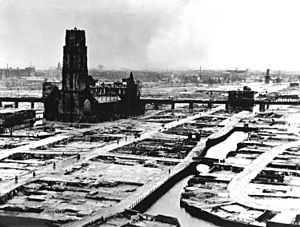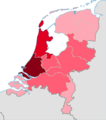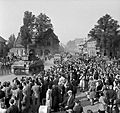Netherlands during World War II facts for kids
Quick facts for kids German occupation of the Netherlands |
|||||||||
|---|---|---|---|---|---|---|---|---|---|
| Part of The Western Front of World War II | |||||||||
 The Dutch City of Rotterdam after Heavy bombing May 14, 1940 |
|||||||||
|
|||||||||
| Belligerents | |||||||||
During World War II, Germany took over the Netherlands by force. This period, from 1940 to 1945, is known as the German occupation. It began with the Battle of the Netherlands on May 10, 1940. Just five days later, on May 15, the Dutch government gave up. The German army then took control of the country. The Dutch government moved to London to continue fighting from abroad. The Netherlands was finally set free on May 5, 1945, when the Germans surrendered to Canadian troops.
Contents
How the Occupation Started
The German Invasion of 1940
In May 1940, Nazi Germany launched a surprise attack on the Netherlands. This attack was part of their plan to conquer Western Europe. The Dutch army fought bravely but was much smaller and less powerful than the German forces.
Bombing of Rotterdam
A key event during the invasion was the bombing of Rotterdam. On May 14, 1940, German planes heavily bombed the city. This caused huge destruction and many deaths. The Dutch government realized they could not stop the German advance.
Dutch Surrender and Government in Exile
Because of the heavy fighting and the bombing of Rotterdam, the Dutch government decided to surrender. This happened on May 15, 1940. To continue the fight against Germany, Queen Wilhelmina and the Dutch government moved to London. They formed a "government in exile" from there.
Life Under German Rule
Changes in Daily Life
After the surrender, Germany took full control of the Netherlands. They set up a new government led by German officials. Daily life changed a lot for Dutch citizens. People faced strict rules and shortages of food and other goods.
Rationing and Shortages
Food, clothing, and other important items became very scarce. The Germans introduced ration stamps. This meant people could only buy a small amount of goods with special coupons. Many families struggled to find enough to eat.
German Control and Propaganda
The Germans tried to control what people thought and heard. They took over newspapers and radio stations. They spread their own messages, known as propaganda. They also tried to make people support their ideas.
The Dutch Resistance
Many Dutch people did not accept the German occupation. They formed secret groups called the Dutch resistance. These brave individuals worked to fight against the Germans in many ways.
Secret Activities of Resistance Fighters
Resistance members helped Jewish people and others hide from the Germans. They also printed secret newspapers to share real news. Some groups even carried out attacks on German soldiers and facilities. They risked their lives every day to help their country.
The End of the Occupation
Allied Liberation of the Netherlands
As World War II continued, the Allied forces, including American, British, and Canadian troops, pushed back against Germany. In September 1944, the southern parts of the Netherlands were liberated.
The Hunger Winter
However, the northern parts of the Netherlands remained under German control. The winter of 1944-1945 was very harsh. The Germans cut off food supplies, leading to a terrible period known as the "Hunger Winter." Thousands of people died from starvation and cold.
Final Liberation in May 1945
Finally, in April and May 1945, Canadian forces advanced into the rest of the Netherlands. The German army in the Netherlands officially surrendered on May 5, 1945. This day is celebrated as Liberation Day in the Netherlands.
Related pages
- Dutch resistance (people who fought against the Nazi occupation of the Netherlands)
Images for kids
-
The city of Rotterdam after the German bombing during the German invasion of the Netherlands in May 1940.
-
Ration stamps from the German-occupied Netherlands
-
Anne Frank's diary has been translated into some sixty languages since its publication
-
Anton Mussert, leader of the NSB, speaking at a rally in The Hague in 1941
-
The NSB rally in Amsterdam where Seyss-Inquart and Mussert spoke about the necessity of invading the Soviet Union, 27 June 1941
-
Members of the Dutch Resistance, identified by their cloth armbands, with American paratroopers of the 101st Airborne Division in Eindhoven, September 1944
-
British Sherman tanks liberate Valkenswaard during Operation Market Garden, September 1944.
-
Canadian troops pass a windmill in Rijssen-Holten, April 1945.




















